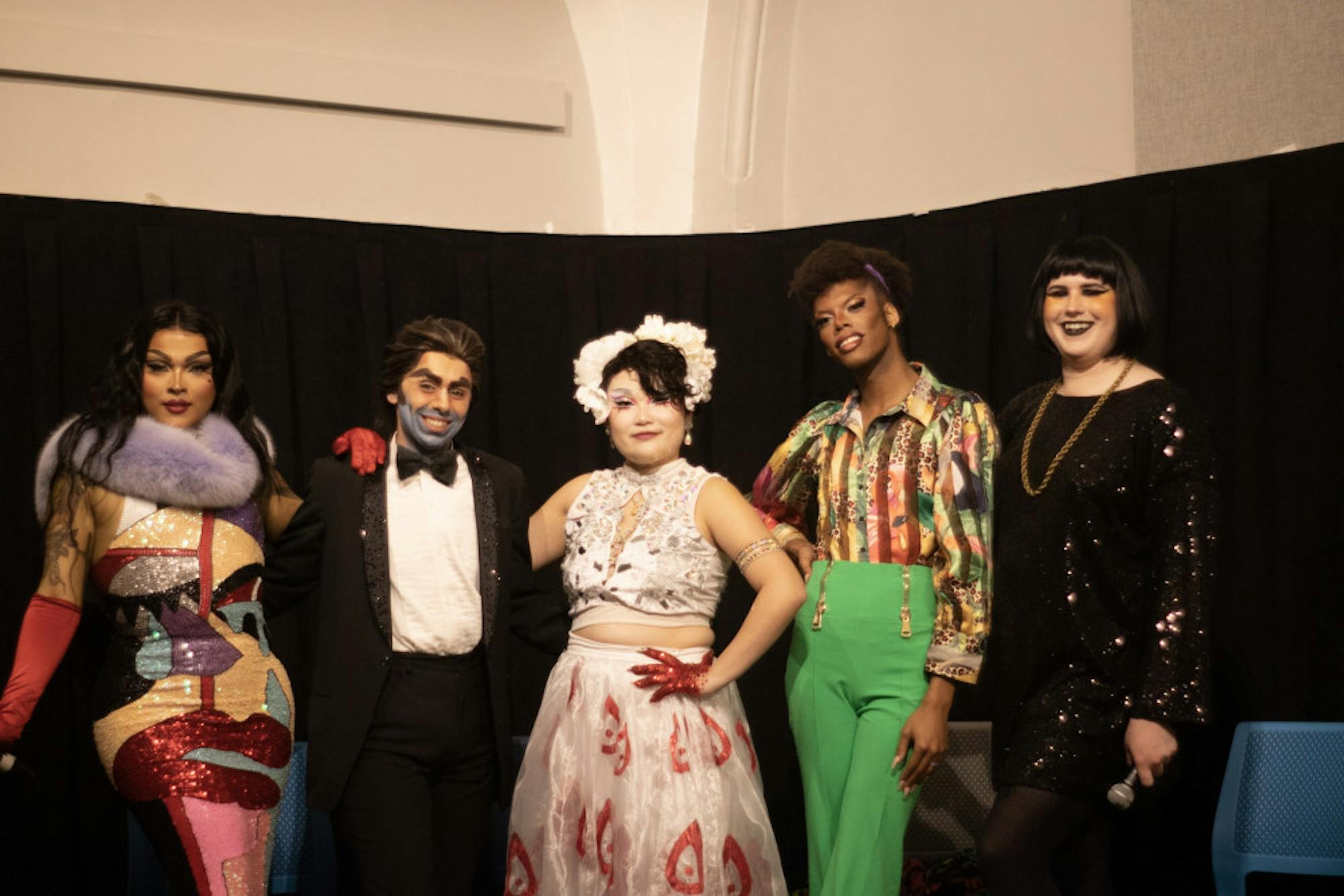Local drag artists Briar Blush, Rusty Hammer, Arabella LaDessé and Hal Apenyo joined the Tufts community in Curtis Hall on Nov. 29 for “Gender as a Show!,” an afternoon of drag performances followed by a panel on the role of gender in drag. The event was sponsored by the Tufts Department of Women’s, Gender, and Sexuality Studies with support from the LGBT Center. WGSS instructor Matisse DuPont moderated the panel in the role of Monstera Délicieux and also offered an introductory performance to start the show.
The event was inspired by DuPont’s curriculum for the course Queering Feminism: Intro to WGSS as well as their experience in the local drag scene. DuPont had planned a lecture with themes related to subversion of gender and boundary-crossing through drag when they had the idea to bring in drag performers for their class.
“I was originally just going to bring in a couple of drag performers to come in … actually out of drag, just to come in and talk to my class,” they said.
When Hilary Binda, director of the Department of Women’s, Gender, and Sexuality Studies, suggested making the discussion a bigger event, DuPont began reaching out to members of the Boston drag scene. While leveraging personal connections, they deliberately assembled the panel to present a variety of artists.
“These [performers] are all people who I was in the scene with before lockdown,” DuPont said. “I also really wanted to make sure that it was a diverse panel in terms of age and ethnicity and race, in terms of class background, … to make sure that we had a really well-rounded set of perspectives.”
The artists presented dynamic and stylistically different performances. Monstera performed Eartha Kitt’s “I Want to Be Evil” (1953), exploring themes of queer-coded villains, while Rusty Hammer offered a sensual performance alongside a song medley including “I’m Too Sexy” (1992). Briar Blush performed an energetic mix of Donna Summer songs. Hal Apenyo performed a number based on the theme of a peacock looking at spring, with choreography inspired by traditional Chinese folk dance as well as their figure skating background. Arabella LaDesse followed with a high-energy Beyonce medley.
The show concluded with a duet from Rusty and Briar as typically performed in their vintage-inspired variety show, The Briar and Rusty Show. This duet was set to Frank Sinatra’s “My Way” and played with traditional gender dynamics through Briar’s upstaging of Rusty’s stereotypical ‘leading man’ role.
This duet was one example of the way that drag can introduce entertaining conversations about gender.
“A lot of [the time], when we talk about gender, it’s because we're talking about oppression,” DuPont said. “One of my favorite parts about drag is it’s able to tackle that while also being fun, playful and entertaining.”
After a short break and words of welcome from Binda, the panel began a series of introductions and a discussion led by Monstera Délicieux. The panelists first discussed what they felt drag was about and how the art form has changed over time. Discussion coalesced around the idea of drag as a way to express and play with the concept of gender.
“What drag is now, it’s just gender expression,” Arabella said. “What it was, which was very much the presentation of gender, is now the destruction of gender.”
Rusty agreed with Arabella’s analysis.
“What I always see drag as is gender performance,” Rusty said. “It doesn’t have to be … impersonation of the gender you’re not, it’s just performance and bringing out the concept that all gender is performance.”
Some panelists highlighted drag as a way to explore different aspects of one’s identity.
“Drag is about breaking down different references and layering different parts of yourself as well as things that inspire you and refracting that through a queer lens,” Hal said.
“I think drag can also be about validating different aspects of yourself and getting more comfortable with them through the stage, through performance and through visuals,” Briar added.
Panelists discussed the different paths they took to drag performance. As drag kings, Hal and Rusty noted the wider representation of drag queens and their realizations that performing as a drag king was an option.
Rusty said he used to believe there were particular formulas for doing drag.
“A couple of years ago, I went to a show that had drag kings booked in it for the first time,” Rusty said. “And then on the next day, I was Googling drag king classes.”
Hal had been exposed to drag through the popularity of RuPaul’s Drag Race but found drag academically before becoming a performer.
“I went to a workshop, and I just wanted to learn general makeup tips,” Hal said. “One of the drag queens there was like, ‘How about we get you in drag?’ and that blew my freaking mind.”
Some of the drag queens found drag as a way to express and explore femininity. Briar found drag after experimenting with expressing femininity through clothing and makeup and found that led naturally to drag performance. Monstera was born from playing with the idea of femininity.
“I got into drag … sort of to rebel against the expectations of being a trans feminine person,” DuPont said. “I want to do the glam version. I want to be extravagant and ridiculous and not just wearing cardigans in an office.”
The discussion ended with an opportunity for audience questions and answers. Audience questions focused on where performers found their outfits and their paths to developing an on-stage aesthetic.
The event sparked greater interest in drag performances among attendees; one audience member asked where they could go in the New England area to watch more drag performances.






